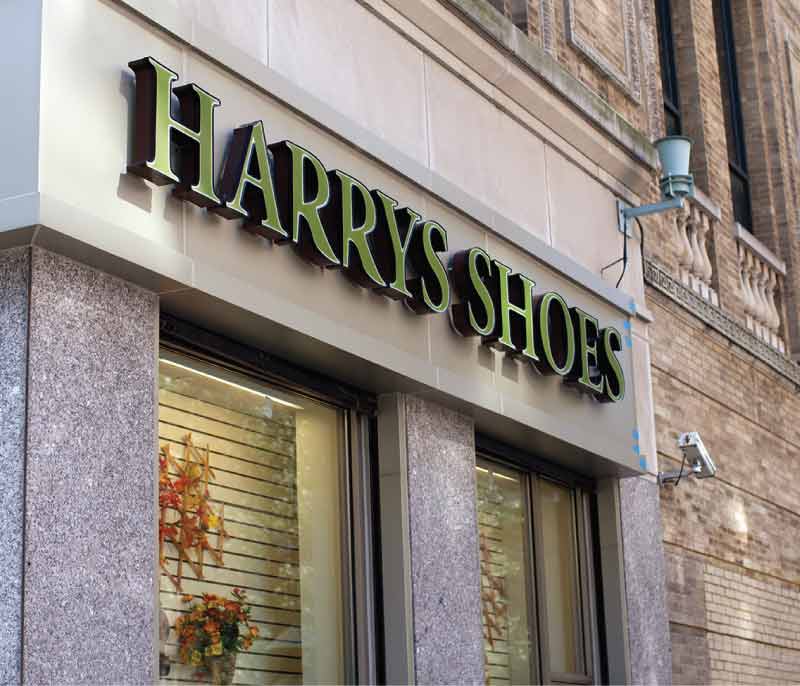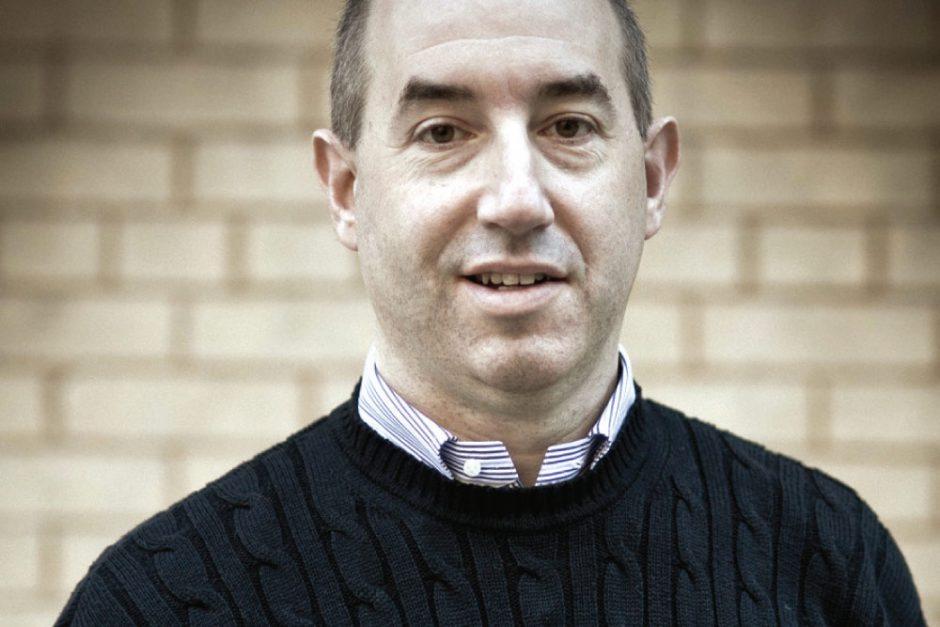Robert Goldberg, president of Harry’s Shoes, is a lifelong student of retail, sitting at the head of the class when it comes to knowing the nuances of the market and always positioning his store ahead of the curve.
 Robert Goldberg, a man in the prime of his life, might seem relatively young to be bestowed a Lifetime Achievement award. That is, until one takes into account how he has spent nearly his entire life in shoe retailing—and has been doing so quite successfully, particularly since taking over the day-to-day reins of the third-generation, family-owned business after the turn of the Millennium. Harry’s Shoes and its offshoot Harry’s Shoes for Kids, located a few doors up the block, have become Upper West Side retail institutions since settling on the corner of 83rd and Broadway in 1975. (There were two prior Manhattan locations since it first opened for business in 1931.) Harry’s Shoes has continually adapted, evolved and—as of 2012—doubled in size to meet the ever-changing wants and needs of its demanding customer base. Goldberg along with his sister, Randi, his “best friend” and business partner, have set the bar on comfort specialty and kids footwear retailing. Ask most anyone in the industry for their opinion of an exceptional store and a wise retailer, and the answer is nearly unanimous: “Harry’s Shoes” and “Robert Goldberg.”
Robert Goldberg, a man in the prime of his life, might seem relatively young to be bestowed a Lifetime Achievement award. That is, until one takes into account how he has spent nearly his entire life in shoe retailing—and has been doing so quite successfully, particularly since taking over the day-to-day reins of the third-generation, family-owned business after the turn of the Millennium. Harry’s Shoes and its offshoot Harry’s Shoes for Kids, located a few doors up the block, have become Upper West Side retail institutions since settling on the corner of 83rd and Broadway in 1975. (There were two prior Manhattan locations since it first opened for business in 1931.) Harry’s Shoes has continually adapted, evolved and—as of 2012—doubled in size to meet the ever-changing wants and needs of its demanding customer base. Goldberg along with his sister, Randi, his “best friend” and business partner, have set the bar on comfort specialty and kids footwear retailing. Ask most anyone in the industry for their opinion of an exceptional store and a wise retailer, and the answer is nearly unanimous: “Harry’s Shoes” and “Robert Goldberg.”
Adjectives used most often to describe Harry’s Shoes include great, elite, exceptional, outstanding and reliable. As for describing Goldberg there is, far and away, one most frequently used descriptive: smart.
“He’s just incredibly smart,” confirms Larry Schwartz, CEO of Aetrex Worldwide. “He’s one of the smartest retailers that I know, and he’s just someone who you can trust and have meaningful conversations with about the business.” More importantly, Schwartz adds, Goldberg is somebody you want to do business with. “Robert’s reasonable, he understands vendors’ needs as well as his own and he’s a pleasure to work with,” he says. “And he has a great store and really knows how to operate it.” Schwartz singles out the great execution spanning service, product assortment and decor. “Harry’s executes as well as anyone,” he says, noting, “Robert’s always thinking and looking forward.”
David Kahan, CEO of Birkenstock Americas, describes Goldberg as “cerebral,” adding that he is a true student of retail and the footwear industry. “Because of his most discerning clientele, Robert must always be thinking a step ahead when it comes to assortment and service,” Kahan says, adding that Goldberg excels at the ability. “He is one of my most highly regarded sources of insight and one of my ‘go-to guys’ when I’m thinking through a decision,” Kahan says. “He always gives insightful feedback and thinks a bit out-of-the-box related to the status quo.”
Echoing Kahan’s thoughts, Bruce Munro, CEO of Munro & Co., describes Goldberg as an “ardent student” of the shoe business. “He has the ability to see the big picture and is progressive about being where his customer needs him to be,” Munro says. “And while he runs a huge retail business, he still understands the value of being on the floor and listening to what the boss [the customer] has to say.”
Good Genes
 One might say the strong retail acumen runs in the Goldberg family. It started with founder Harry Goldberg, flowed down to his son, Joe, and has since been passed onto his son, Robert. Innate retailing ability is unquestionably part of Goldberg’s makeup. “I guess, on some level for my sister and I, shoes were in our blood,” he says. “The natural tendencies that we were always around. It was an instinct, almost.”
One might say the strong retail acumen runs in the Goldberg family. It started with founder Harry Goldberg, flowed down to his son, Joe, and has since been passed onto his son, Robert. Innate retailing ability is unquestionably part of Goldberg’s makeup. “I guess, on some level for my sister and I, shoes were in our blood,” he says. “The natural tendencies that we were always around. It was an instinct, almost.”
Beyond that gift has always been a keen eye and studious approach to continually learn about the business. It began as a child, watching his father methodically go about running the store. In fact, he and his sister would on occasion tag along with their dad to local shoe shows on Sundays for a little quality time. “That was the only day off he had, so if we wanted to see him we would go to the show,” Goldberg recalls. “We’d walk around the old Coliseum and various hotels.”
What Goldberg first noticed—and learned a great deal from—during those trips was the passion his father had for his job and just how good he was at it. It was inspiring. “To see the level of passion, attention to detail and focus my father had on what he was doing…I sat there and said to myself, ‘Gee, I’d love to be good like that some day,’” Goldberg offers, noting, “So much of it was just instinctual to him.” For example, Goldberg cites his father’s uncanny ability to spot trends. “He had an eye for catching and understanding trends, and understood how to merchandise—buy it narrow and deep,” he says. “He had the ability to understand what was beyond the surface; an instinctual gut feeling for things.” Goldberg adds, “It’s everything they talk about today, but probably don’t do it as well.”
It was not, however, as if the Goldberg kids were being indoctrinated into the family business. As a rule, their father forbade them from working in the store. He wanted his kids to be kids. But that didn’t stop the younger Goldberg from earning his shoe retailing stripes early on, first by selling shoes at a local Florsheim store during high school summers and, later while attending Vassar College, at Barney’s. Upon graduation, Goldberg was recruited into the Macy’s executive training program where he worked for about a year toward becoming a buyer. It was a pivotal time in his life. “That’s when I decided I really do like the shoe business and retail,” he says. It was also then that his father decided he didn’t want to lose his son to a department store career track and asked him to join the family business. The request, Goldberg says, was made “in the late ’80s.” So was it destiny, fate or all according to plan? Goldberg doesn’t really know, for sure. “It was always in the back of my mind,” he says, regarding whether he might one day work at Harry’s Shoes. “But you just don’t know until you know.”
Goldberg got his start as a women’s manager and soon after became the category’s buyer. From that point, it was a steady accumulation of responsibilities as he gained experience and his father grew older and abdicated his duties. He took charge of men’s and kids’ buying and, pretty soon, whatever else needed doing that culminated in being in charge of all merchandising. “It’s a family business, so I also helped manage the store and train the staff,” he says. “You have to be a jack-of-all-trades.”
Goldberg has been doing exactly that for more than a decade. A typical day involves checking in early and making sure everything is running smoothly, followed by meetings with vendors. He’ll also get onto the sales floor to “check in” with customers, seeing what’s going on and what products they like. “I really try to make it my business to be on the floor as often as I can,” he notes. “I also try to make it into my stockroom periodically, as well.” (Rumor has it the stockroom is quite vast and extends underground across Broadway.) Goldberg will also meet with his buying team daily to get their read on what’s moving and if they’ve got any feedback on what’s going on in the marketplace at large. “We’ll review sales and discuss future elements, whether it relates to marketing or current trends that we need to be thinking about. And we’ll look at the weather forecast,” Goldberg offers, adding, “It’s a very hands-on kind of process.” Asked if it’s a seven-days-a-week process, Goldberg responds, “Amen.”
In that regard, Goldberg has a knack for being matter of fact. It’s often packaged in the wry frankness of a lifelong New Yorker. When asked, for example, how’s business of late? His response, “Well, how was the weather?” Few would argue that the weather has been quite unpredictable and, more to the point, downright weird. This past February felt more like mid-May on several occasions in the New York area. According to Goldberg, “Business was the same.”
Strange Days
Ever the student who is trying to learn the latest ins and outs of the business, Goldberg says that the current challenges go beyond the wacky weather of the past few years. Buy now/wear now, direct-to-consumer (DTC) and online sellers are all impacting how, when and where consumers shop. Specifically, he cites a “dilution” of consumer demand. “People feel as if they can get it anytime and anywhere,” he says. “So weather becomes more of an inducing factor because there is more of an immediacy.” Goldberg says the result is a definite shift in terms of the sense of importance to immediacy across all consumer goods categories, which is forcing Harry’s to change its product flow. “You deliver a little later. You marry things more against when typical weather patterns hit,” he offers. “Seasons run longer, meaning we’ll sell sandals into September when it can still hit 90 degrees. You shift the calendar, which department stores will never do because it’s too arduous.”
In that regard, Goldberg remains a firm believer in the future viability of independent shoe retailers, which have survived catalogs, department stores and big box discounters. He expects the good ones will also retain a foothold against the latest category killers, fast fashion chains and e-tailers. Why? “Because we’re much more nimble,” he says.
Goldberg is surely not naive to the threat online retailers—namely Amazon—pose to his business as well as the industry as a whole. At the same time, he is not overly consumed by it, choosing instead to focus on the aspects he can control and maximize his brick-and-mortar advantages. When asked how shopping inside Harry’s differs from an online experience, Goldberg responds: “Online is kind of one-dimensional. It’s teaching you how to buy shoes in your living room, but feet have a lot of pressure points and it’s still a touch-and-feel business.” He continues, “Look at the return rates online. Many are coming to the realization that the so-called convenience factor is not all that convenient. Returns, which are frequent, are a hassle. Even if it’s free freight, it’s a hassle.”
Asked if he believes the numerous reports of brick-and-mortar retail’s death spiral is accurate, Goldberg responds, “If somebody told me I should jump off a bridge, I’d ask, ‘Why?’” He believes online remains a bit of a novelty that will eventually subside, especially when prices and fees rise—something that he predicts will happen in order to become profitable.
Regardless, Goldberg believes it’s a folly to try and out-Amazon Amazon. Especially for retail businesses, which he says, Amazon is clearly not. “They are a technology company,” he says, adding that trying to compete against any major online entity is a losing proposition on two fronts. “They’re always going to be quicker to the newest technology and be able to boil down the competitive levels to the point where they are able to take the air out of the room against anybody who is P&L-based,” he states. Along those lines, he says it’s nearly impossible to be profitable selling footwear strictly online. “I don’t believe the metrics in the online space, from a retailer’s perspective, are ever going to work,” he offers. “The costs based on freight, logistics and return rate percentage already puts you at a disadvantage versus selling it through a store where the consumer can touch and feel the product and you can work with them.”
Back to the Future
Goldberg’s take on online category killers (what’s left of them besides Amazon) is similar to how he views vendors that are expanding their DTC efforts. It’s another form of competition forcing him to think differently and react, for starters, with a merchandise selection that is not in direct competition with those margin-eroding platforms. Like all traditional retailers who have found ways to adapt and thrive, Goldberg has confidence in his abilities and belief in his format. “At the end of the day, consumers still want and need to see footwear,” he says. “They’re not going to buy everything online.” In fact, Goldberg sees DTC as both an “enemy and an ally” that actually will enhance stores like Harry’s Shoes going forward as vendors will need the remaining physical stores as points of reference. “The smart brands will look to the stores that are left to partner,” he says. “They will understand our importance more than ever because they are going to need us to be their windows to the world.”
Count Kahan as one who fully expects Harry’s Shoes to remain a vital player in the retail landscape in the years ahead. And it all starts with Goldberg‘s leadership abilities and willingness to change. “Instead of just taking over a long-standing family business and babysitting the legacy, Robert has evolved and led the transformation from an old school, sit-and-fit comfort store to a destination for high-quality shoes from brands that have the highest equity with his consumers,” he says. Kahan cites, in particular, Goldberg’s shared vision of Birkenstock that enabled the brand to establish a meaningful footprint in New York. “He had the discipline to do the right thing that is not driven by price, but by assortment and service,” he says. “It’s an incredible testament to his ability. Robert is focused on thriving while others are focused on surviving. It’s a big difference. It’s OK to win instead of playing not to lose.”
Munro tells of a similar story of fruitful partnership that began in 1995 with Robert and his father. “We started small, but the business and relationship grew quickly because of their expertise at nurturing and growing branded relationships,” he says, adding, “Robert looks at his branded partners as an extension of the Harry’s brand and is willing to contribute his significant retail and product knowledge to the betterment of the partnership.” Munro says the partnership also involves a shared passion for building long-term relationships with consumers. “He is always looking ahead, instead dwelling on the past,” he says. “Robert is also one of very few retailers that I’ve come across in my career who understands that a product’s value is better measured by its points of difference and consumers’ satisfaction, rather than simply its retail price.”
All things considered, the long-running success of Harry’s Shoes is no accident. The groundwork was laid by earlier Goldberg generations, but the store’s rise to prominence as one of the most influential and respected businesses in the industry lies squarely in the talents, brains, passion and hard work of its current president: Robert Goldberg. Like many a successful retailer, he’s always open and hungry to learning more. Asked what he loves most about his job beyond product and customers, Goldberg responds, “It’s never boring and, every day, there’s something new. I love trying to figure everything out.”
Amid the ongoing tremendous sea of industry change, the challenge to ”figure everything out” is greater than ever. But Goldberg remains undeterred. “I’m very curious to see what happens,” he says. An avid watcher of CNBC every morning, he tries to keep abreast of the ongoing retail shakeout and how it might impact Harry’s Shoes. It’s a war and every day brings a new fight. “I’m a gladiator,” Goldberg says. “I go to work every day and look to see what I’ve got to deal with and do to survive. You fight the war.” Along those lines, arming oneself with knowledge is the most effective weapon. “You want to make sure that you are informed,” Goldberg says. “You have to be involved in your business. There’s no substitute for that.”




